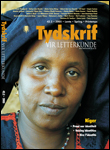Symbols of leadership and conceptions of power in Hausa Literature: An intertextual reading of a Dodo folktale and a popular song
DOI:
https://doi.org/10.4314/tvl.v42i2.29704Keywords:
Dodo folktales, popular Hausa praise songs, intertextuality, powerAbstract
This article presents a brief exploration of the interface between the collective or ancestral archetype of the “Dodo”, symbolising destructive power in Hausa tales and the more individual interpretation and stylistic concerns of a contemporary popular singer, Ali Na Maliki, addressing, at another level, the subject of power and leadership portrayed by the traditional chief. The paper will focus on the interaction between genres, seen in the light of intertextuality as defined by Michael Riffaterre and M.H. Abrams among others. It highlights, moreover, the thematic and aesthetic contribution of the oral artist Ali Na Maliki to contemporary Hausa orature and culture. It reposes on an analysis of the manipulation of certain images and animal symbols of leadership and power borrowed from the world of tales used with a certain degree of innovation in order to evoke, symbolically, the mythical attributes of power in the artistic universe of his songs.
Downloads
References
Abraham, R.C. 1949. Dictionary of the Hausa Language. London: University of London Press.
Abrams, M.H. 1988. A Glossary of Literary Terms. New York: Holt, Rinchart and Winston, Inc.
Bargery, G.P. 1934. A Hausa-English Dictionary and English-Hausa Vocabulary. Vol. 4. London: Oxford University Press.
Bello, Zainab Ibrahim. 1991. Wasannin Taushe a Kasar Hausa. Zaria, Nigeria: Gaskiya Corporation.
Brown, Alison. 1995. Introduction. In Alison, Brown (ed.) Language and Images of Renaissance Italy. New York: Clarendon Press, 7-26.
Calame-Griaule, Geneviève (ed.). 1969. Le Théme de l’Arbre dans les Contes Africains. Vol. 1. Paris: SELAF.
Calame-Griaule, Geneviève (ed.). 1970. Le Thème de l’Arbre dans les Contes Africains. Vol. 2. Paris: SELAF.
Calame-Griaule, Geneviève (ed.). 1974. Le Théme de l’Arbre dans les Contes Africains. Vol. 3. Paris: SELAF.
Frye, Northop. 1990. Anatomy of Criticism: four essays. Princeton: Princeton University Press.
Genette, Gérard. 1993. Fiction and Diction. Trans. Catherine Porter. Ithaca: Cornell University Press.
Glew, Robert S. & Chaibou, Babale. 1993. Hausa Folktales from Niger. Athens: Ohio University.
Hunter, Linda & Chaibou, Elhadji Oumarou. 2001. Aspects of the Aesthetics of Hausa Verbal Art. Cologne: Rüdiger Köppe Verlag.
Moulin, Nicole. 1984. Saraounia en pays maouri: Lugu – Niger. Unpublished dissertation Paris: DEA; Institut d’Ethnologie.
Nicolas, Guy. 1975. Dynamique Sociale et Appréhension du Monde au Sein d’une Société Haoussa. Paris: Institut d’Ethnologie.
Oumarou, Chaibou Elhadji. 1996. Individual Talent in Contemporary Hausa Oral Poetry. Unpublished Ph.D. dissertation. Madison: University of Wisconsin.
Riffaterre, Michael. 1979. Sémiotique Intertextuelle: l’Interprétant. Revued’Esthétique 1-2: 128-150.
Riffaterre, Michael. 1980. La Trace de l’Intertexte. La Pensée 215: 4-18.
Scheub, Harold. 1985. A Review of African Oral Traditions and literature. African Studies Review 28 (2/3):1-72.
Stephens, Connie L. 1981. The Relationships of Social Symbols and Narrative Metaphor: A Study of Fantasy and Disguise in the Hausa Tatsumya of Niger. Unpublished Ph.D. dissertation. Madison: University of Wisconsion.
Stora, Renée. 1978. Le Test de l’Arbre. Paris: PUF.
Downloads
Published
Issue
Section
License
Copyright (c) 2005 Tydskrif vir Letterkunde

This work is licensed under a Creative Commons Attribution-ShareAlike 4.0 International License.


 https://orcid.org/0000-0001-6465-6584
https://orcid.org/0000-0001-6465-6584


.png)